Microstructural Relationship between Olivine and Clinopyroxene in Ultramafic Rocks from the Red Hills Massif, Dun Mountain Ophiolite
Abstract
:1. Introduction
2. Geological Setting
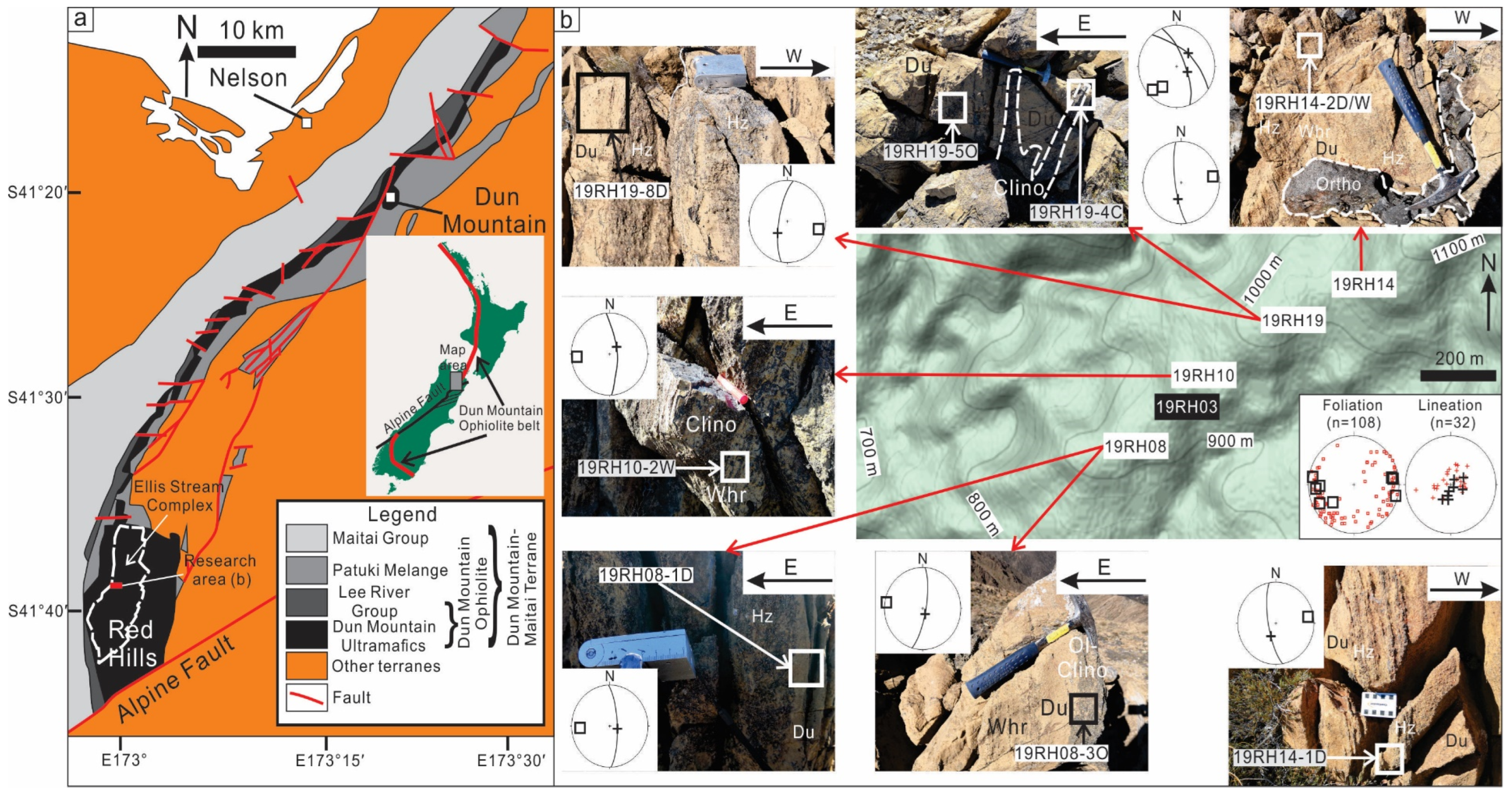
3. Materials and Methods
3.1. Sample Preparation
3.2. Electron Backscatter Diffraction (EBSD) Analysis
3.3. M Index and BA/LS Index
4. Results
4.1. General Information and Microstructural Observation
4.2. CPO and SPO (Shape Preferred Orientations) Data
4.3. Other Microstructural Information
5. Discussion
5.1. Identification of Melted Phases during Mantle Evolution
5.2. Deformation of the Clinopyroxene-Related Ultramafic Rocks
5.2.1. Olivine
5.2.2. Clinopyroxene
5.3. Tectonic Evolution Recovery
6. Conclusions
Author Contributions
Funding
Data Availability Statement
Acknowledgments
Conflicts of Interest
References
- Smyth, J.; Bell, D.; Rossman, G. Incorporation of hydroxyl in upper-mantle clinopyroxenes. Nature 1991, 351, 732–735. [Google Scholar] [CrossRef]
- Muramoto, M.; Michibayashi, K.; Ando, J.; Kagi, H. Rheological contrast between garnet and clinopyroxene in the mantle wedge: An example from Higashi-akaishi peridotite mass, SW Japan. Phys. Earth Planet. Inter. 2011, 184, 14–33. [Google Scholar] [CrossRef]
- Picazo, S.; Müntener, O.; Manatschal, G.; Bauville, A.; Karner, G.; Johnson, C. Mapping the nature of mantle domains in Western and Central Europe based on clinopyroxene and spinel chemistry: Evidence for mantle modification during an extensional cycle. Lithos 2016, 266, 233–263. [Google Scholar] [CrossRef]
- Ionov, D.; Chanefo, I.; Bodinier, J. Origin of Fe-rich lherzolites and wehrlites from Tok, SE Siberia by reactive melt percolation in refractory mantle peridotites. Contrib. Mineral. Petrol. 2005, 150, 335–353. [Google Scholar] [CrossRef]
- Xiao, Y.; Zhang, H.; Fan, W.; Ying, J.; Zhang, J.; Zhao, X.; Su, B. Evolution of lithospheric mantle beneath the Tan-Lu fault zone, eastern North China Craton: Evidence from petrology and geochemistry of peridotite xenoliths. Lithos 2010, 117, 229–246. [Google Scholar] [CrossRef]
- Marchesi, C.; Konc, Z.; Garrido, C.J.; Bosch, D.; Hidas, K.; Varas-Reus, M.I.; Acosta-Vigil, A. Multi-stage evolution of the lithospheric mantle beneath the westernmost Mediterranean: Geochemical constraints from peridotite xenoliths in the eastern Betic Cordillera (SE Spain). Lithos 2017, 276, 75–89. [Google Scholar] [CrossRef]
- Tommasi, A.; Vauchez, A.; Godard, M.; Belley, F. Deformation and melt transport in a highly depleted peridotite massif from the Canadian Cordillera: Implications to seismic anisotropy above subduction zones. Earth Planet. Sci. Lett. 2006, 252, 245–259. [Google Scholar] [CrossRef]
- Shao, Y.; Prior, D.; Toy, V.; Negrini, M.; Scott, J. Does second phase content control the evolution of olivine CPO type and deformation mechanisms? A case study of paired harzburgite and dunite bands in the Red Hills Massif, Dun Mountain Ophiolite. Lithos 2021, 406, 106532. [Google Scholar] [CrossRef]
- Tommasi, A.; Vauchez, A.; Ionov, D.A. Deformation, static recrystallization, and reactive melt transport in shallow subcontinental mantle xenoliths (Tok Cenozoic volcanic field, SE Siberia). Earth Planet. Sci. Lett. 2008, 272, 65–77. [Google Scholar] [CrossRef]
- Wei, B.; Jin, Z.; Zhang, J. Deformation microstructures and mechanism of ultrahigh-pressure garnet wehrlite from Bixiling, Dabie Mountains. Earth Sci. -J. China Univ. Geosci. 2013, 38, 983–994, (Chinese with English abstract). [Google Scholar]
- Park, Y.; Jung, H. Deformation microstructures of olivine and pyroxene in mantle xenoliths in Shanwang, eastern China, near the convergent plate margin, and implications for seismic anisotropy. Int. Geol. Rev. 2015, 57, 629–649. [Google Scholar] [CrossRef]
- Godard, G.; van Roermund, H.L.M. Deformation-induced clinopyroxene fabrics from ecologites. J. Struct. Geol. 1995, 17, 1425–1443. [Google Scholar] [CrossRef]
- Bascou, J.; Tommasi, A.; Mainprice, D. Plastic deformation and development of clinopyroxene lattice preferred orientations in eclogites. J. Struct. Geol. 2002, 24, 1357–1368. [Google Scholar] [CrossRef]
- Frets, E.; Tommasi, A.; Garrido, C.; Padrón-Navarta, J.; Amri, I.; Targuisti, K. Deformation processes and rheology of pyroxenites under lithospheric mantle conditions. J. Struct. Geol. 2012, 39, 138–157. [Google Scholar] [CrossRef]
- Higgie, K.; Tommasi, A. Deformation in a partially molten mantle: Constraints from plagioclase lherzolites from Lanzo, western Alps. Tectonophysics 2014, 615–616, 167–181. [Google Scholar] [CrossRef]
- Puelles, P.; Ábalos, B.; Gil Ibarguchi, J.; Sarrionandia, F.; Carracedo, M.; Fernández-Armas, S. Petrofabric and seismic properties of lithospheric mantle xenoliths from the Calatrava volcanic field (Central Spain). Tectonophysics 2016, 683, 200–215. [Google Scholar] [CrossRef]
- Chatzaras, V.; Kruckenberg, S.C. Effects of melt-percolation, refertilization and deformation on upper mantle seismic anisotropy: Constraints from peridotite xenoliths, Marie Byrd Land, West Antarctica. Geol. Soc. Lond. Mem. 2021, 56, 151–180. [Google Scholar] [CrossRef]
- Sano, S.; Kimura, J. Clinopyroxene REE Geochemistry of the Red Hills Peridotite, New Zealand: Interpretation of Magmatic Processes in the Upper Mantle and in the Moho Transition Zone. J. Petrol. 2007, 48, 113–139. [Google Scholar] [CrossRef]
- Chin, E.; Soustelle, V.; Liu, Y. An SPO-induced CPO in composite mantle xenoliths correlated with increasing melt-rock interaction. Geochim. Cosmochim. Acta 2020, 278, 199–218. [Google Scholar] [CrossRef]
- Henry, H.; Kaczmarek, M.; Ceuleneer, G.; Tilhac, R.; Griffin, W.; O’Reilly, S.; Grégoire, M.; Le Sueur, E. The microstructure of layered ultramafic cumulates: Case study of the Bear Creek intrusion, Trinity ophiolite, California, USA. Lithos 2021, 388–389, 106047. [Google Scholar] [CrossRef]
- Polvé, M.; Allgre, C. Orogenic lherzolite complexes studied by 87Rb-87Sr: A clue to understand the mantle convection processes? Earth Planet. Sci. Lett. 1980, 51, 71–93. [Google Scholar] [CrossRef]
- Allègre, C.; Turcotte, D. Implications of a two-component marble-cake mantle. Nature 1986, 323, 123–127. [Google Scholar] [CrossRef]
- Lambart, S.; Baker, M.; Stolper, E. The role of pyroxenite in basalt genesis: Melt-PX, a melting parameterization for mantle pyroxenites between 0.9 and 5 GPa. J. Geophys. Res. Solid Earth 2016, 121, 5708–5735. [Google Scholar] [CrossRef]
- Henry, H.; Tilhac, R.; Griffin, W.; O’Reilly, S.; Satsukawa, T.; Kaczmarek, M.; Grégoire, M.; Ceuleneer, G. Deformation of mantle pyroxenites provides clues to geodynamic processes in subduction zones: Case study of the Cabo Ortegal Complex, Spain. Earth Planet. Sci. Lett. 2017, 472, 174–185. [Google Scholar] [CrossRef]
- Zhao, X.; Wang, H.; Li, Z.; Evans, N.J.; Ying, J.; Yang, Y.; Zhang, H. Nature and evolution of lithospheric mantle beneath the western North China Craton: Constraints from peridotite and pyroxenite xenoliths in the Sanyitang basalts. Lithos 2021, 384–385, 105987. [Google Scholar] [CrossRef]
- Ackerman, L.; Jelínek, E.; Medaris, G., Jr.; Ježek, J.; Siebel, W.; Strnad, L. Geochemistry of Fe-rich peridotites and associated pyroxenites from Horní Bory, Bohemian Massif: Insights into subduction-related melt–rock reactions. Chem. Geol. 2009, 259, 152–167. [Google Scholar] [CrossRef]
- Chetouani, K.; Bodinier, J.; Garrido, C.; Marchesi, C.; Amri, I.; Targuisti, K. Spatial variability of pyroxenite layers in the Beni Bousera orogenic peridotite (Morocco) and implications for their origin. Comptes Rendus Geosci. 2016, 348, 619–629. [Google Scholar] [CrossRef]
- Bodinier, J.; Godard, M. Orogenic, ophiolitic, and abyssal peridotites. Treatise Geochem. 2003, 2, 103–170. [Google Scholar]
- Maruyama, G.; Hiraga, T. Grain-to multiple-grain-scale deformation processes during diffusion creep of forsterite+ diopside aggregate: 1. Direct observations: Journal of Geophysical Research. Solid Earth 2017, 122, 5890–5915. [Google Scholar] [CrossRef]
- Zhao, N.; Hirth, G.; Cooper, R.; Kruckenberg, S.; Cukjati, J. Low viscosity of mantle rocks linked to phase boundary sliding. Earth Planet. Sci. Lett. 2019, 517, 83–94. [Google Scholar] [CrossRef]
- Bystricky, M.; Kunze, K.; Burlini, L.; Burg, J. High shear strain of olivine aggregates: Rheological and seismic consequences. Science 2000, 290, 1564–1567. [Google Scholar] [CrossRef] [PubMed]
- Stewart, E.; Lamb, W.; Newman, J.; Tikoff, B. The petrological and geochemical evolution of early forearc mantle lithosphere: An example from the Red Hills Ultramafic Massif, New Zealand. J. Petrol. 2016, 57, 751–776. [Google Scholar] [CrossRef]
- Christensen, N. Structure and origin of the Dun Mountain ultramafic massif, New Zealand. Geol. Soc. Am. Bull. 1984, 95, 551–558. [Google Scholar] [CrossRef]
- Coombs, D.; Landis, C.; Norris, R.; Sinton, J.; Borns, D.; Craw, D. The Dun Mountain ophiolite belt, New Zealand, its tectonic setting, constitution, and origin, with special reference to the southern portion. Am. J. Sci. 1976, 276, 561–603. [Google Scholar] [CrossRef]
- Davis, T.; Johnston, M.; Rankin, P.; Stull, R. The Dun Mountain ophiolite belt in East Nelson, New Zealand. In Proceedings of the International Ophiolite Symposium, Nichoisa, Cyprus, 1–8 April 1979; Cyprus Ministry of Agriculture and Natural Resources: Nicosia, Cyprus, 1980; pp. 480–498. [Google Scholar]
- Stewart, E.; Newman, J.; Tikoff, B.; Donnelly, S.; German, L.; Chatzaras, V.; Lamb, W.; Miller, B.; Kruckenberg, S. Coupled deformation and melt-migration events recording subduction initiation, Dun Mountain ophiolite, New Zealand. Geol. Soc. Lond. Mem. 2019, 49, 93–117. [Google Scholar] [CrossRef]
- Johnston, M. Sheet O27AC Dun Mountain, Geological Map of New Zealand 1: 50 000: Map (1 Sheet) and Notes (40p); New Zealand Department of Scientific and Industrial Research: Nelson, New Zealand, 1981.
- Sano, S.; Tazaki, K.; Koide, Y.; Nagao, T.; Watanabe, T.; Kawachi, Y. Geochemistry of dike rocks in Dun mountain ophiolite, Nelson, New Zealand. N. Z. J. Geol. Geophys. 1997, 40, 127–136. [Google Scholar] [CrossRef]
- Webber, C.; Little, T.; Newman, J.; Tikoff, B. Fabric superposition in upper mantle peridotite, Red Hills, New Zealand. J. Struct. Geol. 2008, 30, 1412–1428. [Google Scholar] [CrossRef]
- Webber, C.; Newman, J.; Holyoke, C.; Little, T.; Tikoff, B. Fabric development in cm-scale shear zones in ultramafic rocks, Red Hills, New Zealand. Tectonophysics 2010, 489, 55–75. [Google Scholar] [CrossRef]
- Kimura, J.; Sano, S. Reactive Melt Flow as the Origin of Residual Mantle Lithologies and Basalt Chemistries in Mid-Ocean Ridges: Implications from the Red Hills Peridotite, New Zealand. J. Petrol. 2012, 53, 1637–1671. [Google Scholar] [CrossRef]
- Walcott, R. Geology of the Red Hill Complex, Nelson, New Zealand. Trans. R. Soc. N. Z. Earth Sci. 1969, 7, 57–88. [Google Scholar]
- Chatzaras, V.; Kruckenberg, S.; Cohen, S.; Medaris, L.; Withers, A.; Bagley, B. Axial-type olivine crystallographic preferred orientations: The effect of strain geometry on mantle texture. J. Geophys. Res. Solid Earth 2016, 121, 4895–4922. [Google Scholar] [CrossRef]
- Lloyd, G. Atomic number and crystallographic contrast images with the SEM: A review of backscattered electron techniques. Mineral. Mag. 1987, 51, 3–19. [Google Scholar] [CrossRef]
- Bestmann, M.; Prior, D. Intragranular dynamic recrystallization in naturally deformed calcite marble: Diffusion accommodated grain boundary sliding as a result of subgrain rotation recrystallization. J. Struct. Geol. 2003, 25, 1597–1613. [Google Scholar] [CrossRef]
- Suwas, S.; Ray, R. Crystallographic Texture of Materials; Springer: London, UK, 2014. [Google Scholar]
- Wright, S.; Nowell, M.; Field, D. A review of strain analysis using electron backscatter diffraction. Microsc. Microanal. 2011, 17, 316–329. [Google Scholar] [CrossRef] [PubMed]
- Hielscher, R.; Schaeben, H. A novel pole figure inversion method: Specification of the MTEX algorithm. J. Appl. Crystallogr. 2008, 41, 1024–1037. [Google Scholar] [CrossRef]
- Bachmann, F.; Hielscher, R.; Schaeben, H. Grain detection from 2d and 3d EBSD data–specification of the MTEX algorithm. Ultramicroscopy 2011, 111, 1720–1733. [Google Scholar] [CrossRef]
- Bachmann, F.; Hielscher, R.; Schaeben, H. Texture analysis with MTEX–free and open source software toolbox. Solid State Phenom. 2010, 160, 63–68. [Google Scholar] [CrossRef]
- Skemer, P.; Katayama, I.; Jiang, Z.; Karato, S. The misorientation index: Development of a new method for calculating the strength of lattice-preferred orientation. Tectonophysics 2005, 411, 157–167. [Google Scholar] [CrossRef]
- Woodcock, N. Specification of fabric shapes using an eigenvalue method. Geol. Soc. Am. Bull. 1977, 88, 1231–1236. [Google Scholar] [CrossRef]
- Vollmer, F. An application of eigenvalue methods to structural domain analysis. Geol. Soc. Am. Bull. 1990, 102, 786–791. [Google Scholar] [CrossRef]
- Mainprice, D.; Bachmann, F.; Hielscher, R.; Schaeben, H. Descriptive tools for the analysis of texture projects with large datasets using MTEX: Strength, symmetry and components. Geol. Soc. Lond. Spec. Publ. 2014, 409, 251–271. [Google Scholar] [CrossRef]
- Ulrich, S.; Mainprice, D. Does cation ordering in omphacite influence development of lattice-preferred orientation? J. Struct. Geol. 2005, 27, 419–431. [Google Scholar] [CrossRef]
- Jung, H.; Karato, S. Water-Induced Fabric Transitions in Olivine. Science 2001, 293, 1460–1464. [Google Scholar] [CrossRef] [PubMed]
- Michibayashi, K.; Oohara, T. Olivine fabric evolution in a hydrated ductile shear zone at the Moho Transition Zone, Oman Ophiolite. Earth Planet. Sci. Lett. 2013, 377–378, 299–310. [Google Scholar] [CrossRef]
- Michibayashi, K.; Mainprice, D.; Fujii, A.; Uehara, S.; Shinkai, Y.; Kondo, Y.; Ohara, Y.; Ishii, T.; Fryer, P.; Bloomer, S.H.; et al. Natural olivine crystal-fabrics in the western Pacific convergence region: A new method to identify fabric type. Earth Planet. Sci. Lett. 2016, 443, 70–80. [Google Scholar] [CrossRef]
- Baptiste, V.; Tommasi, A.; Vauchez, A.; Demouchy, S.; Rudnick, R.L. Deformation, hydration, and anisotropy of the lithospheric mantle in an active rift: Constraints from mantle xenoliths from the North Tanzanian Divergence of the East African Rift. Tectonophysics 2015, 639, 34–55. [Google Scholar] [CrossRef]
- Zhang, S.; Karato, S.; Gerald, J.; Faul, U.; Zhou, Y. Simple shear deformation of olivine aggregates. Tectonophysics 2000, 316, 133–152. [Google Scholar] [CrossRef]
- Ramsay, J.G. Development of chevron folds. Geol. Soc. Am. Bull. 1974, 85, 1741–1754. [Google Scholar] [CrossRef]
- Soustelle, V.; Tommasi, A.; Bodinier, J.; Garrido, C.; Vauchez, A. Deformation and Reactive Melt Transport in the Mantle Lithosphere above a Large-scale Partial Melting Domain: The Ronda Peridotite Massif, Southern Spain. J. Petrol. 2009, 50, 1235–1266. [Google Scholar] [CrossRef]
- Soustelle, V.; Tommasi, A.; Demouchy, S.; Franz, L. Melt-rock interactions, deformation, hydration and seismic properties in the sub-arc lithospheric mantle inferred from xenoliths from seamounts near Lihir, Papua New Guinea. Tectonophysics 2013, 608, 330–345. [Google Scholar] [CrossRef]
- Tommasi, A.; Baptiste, V.; Vauchez, A.; Holtzman, B. Deformation, annealing, reactive melt percolation, and seismic anisotropy in the lithospheric mantle beneath the southeastern Ethiopian rift: Constraints from mantle xenoliths from Mega. Tectonophysics 2016, 682, 186–205. [Google Scholar] [CrossRef]
- Miranda, E.; Hirth, G.; John, B. Microstructural evidence for the transition from dislocation creep to dislocation-accommodated grain boundary sliding in naturally deformed plagioclase. J. Struct. Geol. 2016, 92, 30–45. [Google Scholar] [CrossRef]
- Závada, P.; Schulmann, K.; Racek, M.; Hasalová, P.; Petr, J.; Weinberg, R.; Štípská, P.; Roberts, A. Role of strain localization and melt flow on exhumation of deeply subducted continental crust. Lithosphere 2018, 10, 217–238. [Google Scholar] [CrossRef]
- Hidas, K.; Borghini, G.; Tommasi, A.; Zanetti, A.; Rampone, E. Interplay between melt infiltration and deformation in the deep lithospheric mantle (External Liguride ophiolite, North Italy). Lithos 2021, 380–381, 105855. [Google Scholar] [CrossRef]
- Shao, Y.; Piazolo, S.; Liu, Y.; Lee, A.; Jin, W.; Li, W.; Liang, C.; Wen, Q. Deformation Behavior and Inferred Seismic Properties of Tonalitic Migmatites at the Time of Pre-melting, Partial Melting, and Post-Solidification. Geochem. Geophys. Geosyst. 2021, 22, e2020GC009202. [Google Scholar] [CrossRef]
- Shao, Y.; Prior, D.J.; Scott, J.M.; Negrini, M. Pre-Alpine Fault Fabrics in Mantle Xenoliths from East Otago, South Island, New Zealand: Journal of Geophysical Research. Solid Earth 2021, 126, e2020JB020196. [Google Scholar] [CrossRef]
- Jung, H.; Katayama, I.; Jiang, Z.; Hiraga, T.; Karato, S. Effect of water and stress on the lattice-preferred orientation of olivine. Tectonophysics 2006, 421, 1–22. [Google Scholar] [CrossRef]
- Liu, W.; Zhang, J.; Barou, F. B-type olivine fabric induced by low temperature dissolution creep during serpentinization and deformation in mantle wedge. Tectonophysics 2018, 722, 1–10. [Google Scholar] [CrossRef]
- Miyazaki, T.; Sueyoshi, K.; Hiraga, T. Olivine crystals align during diffusion creep of Earth’s upper mantle. Nature 2013, 502, 321–326. [Google Scholar] [CrossRef]
- Précigout, J.; Hirth, G. B-type olivine fabric induced by grain boundary sliding. Earth Planet. Sci. Lett. 2014, 395, 231–240. [Google Scholar] [CrossRef]
- Katayama, I.; Karato, S. Effect of temperature on the B- to C-type olivine fabric transition and implication for flow pattern in subduction zones. Phys. Earth Planet. Inter. 2006, 157, 33–45. [Google Scholar] [CrossRef]
- Raterron, P.; Amiguet, E.; Chen, J.; Li, L.; Cordier, P. Experimental deformation of olivine single crystals at mantle pressures and temperatures. Phys. Earth Planet. Inter. 2009, 172, 74–83. [Google Scholar] [CrossRef]
- van der Wal, D.; Chopra, P.; Drury, M.; Fitz Gerald, J. Relationships between dynamically recrystallized grain size and deformation conditions in experimentally deformed olivine rocks. Geophys. Res. Lett. 1993, 20, 1479–1482. [Google Scholar] [CrossRef]
- Tommasi, A.; Tikoff, B.; Vauchez, A. Upper mantle tectonics: Three-dimensional deformation, olivine crystallographic fabrics and seismic properties. Earth Planet. Sci. Lett. 1999, 168, 173–186. [Google Scholar] [CrossRef]
- Kumamoto, K.; Warren, J.; Hansen, L. Evolution of the Josephine Peridotite Shear Zones: 2. Influences on Olivine Cpo Evolution. J. Geophys. Res. Solid Earth 2019, 124, 12763–12781. [Google Scholar] [CrossRef]
- Tommasi, A.; Mameri, L.; Godard, M. Textural and compositional changes in the lithospheric mantle atop the Hawaiian plume: Consequences for seismic properties. Geochem. Geophys. Geosyst. 2020, 21, e2020GC009138. [Google Scholar] [CrossRef]
- Jung, H.; Park, M.; Jung, S.; Lee, J. Lattice preferred orientation, water content, and seismic anisotropy of orthopyroxene. J. Earth Sci. 2010, 21, 555–568. [Google Scholar] [CrossRef]
- Zaffarana, C.; Tommasi, A.; Vauchez, A.; Grégoire, M. Microstructures and seismic properties of south Patagonian mantle xenoliths (Gobernador Gregores and Pali Aike). Tectonophysics 2014, 621, 175–197. [Google Scholar] [CrossRef]
- Fernández-Roig, M.; Galán, G.; Mariani, E. Deformation and seismic anisotropy of the subcontinental lithospheric mantle in NE Spain: EBSD data on xenoliths from the Catalan Volcanic Zone. Tectonophysics 2017, 698, 16–37. [Google Scholar] [CrossRef]

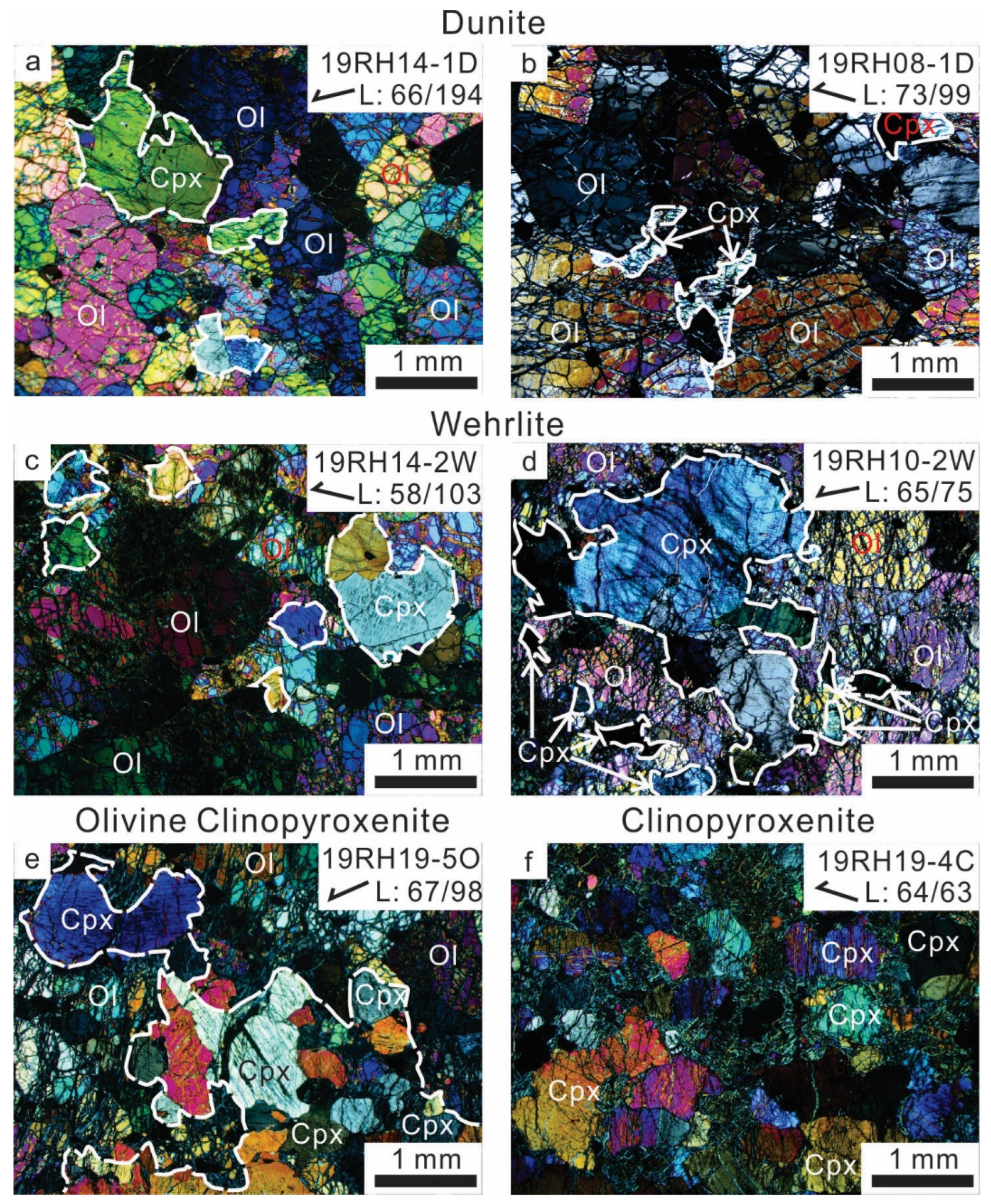
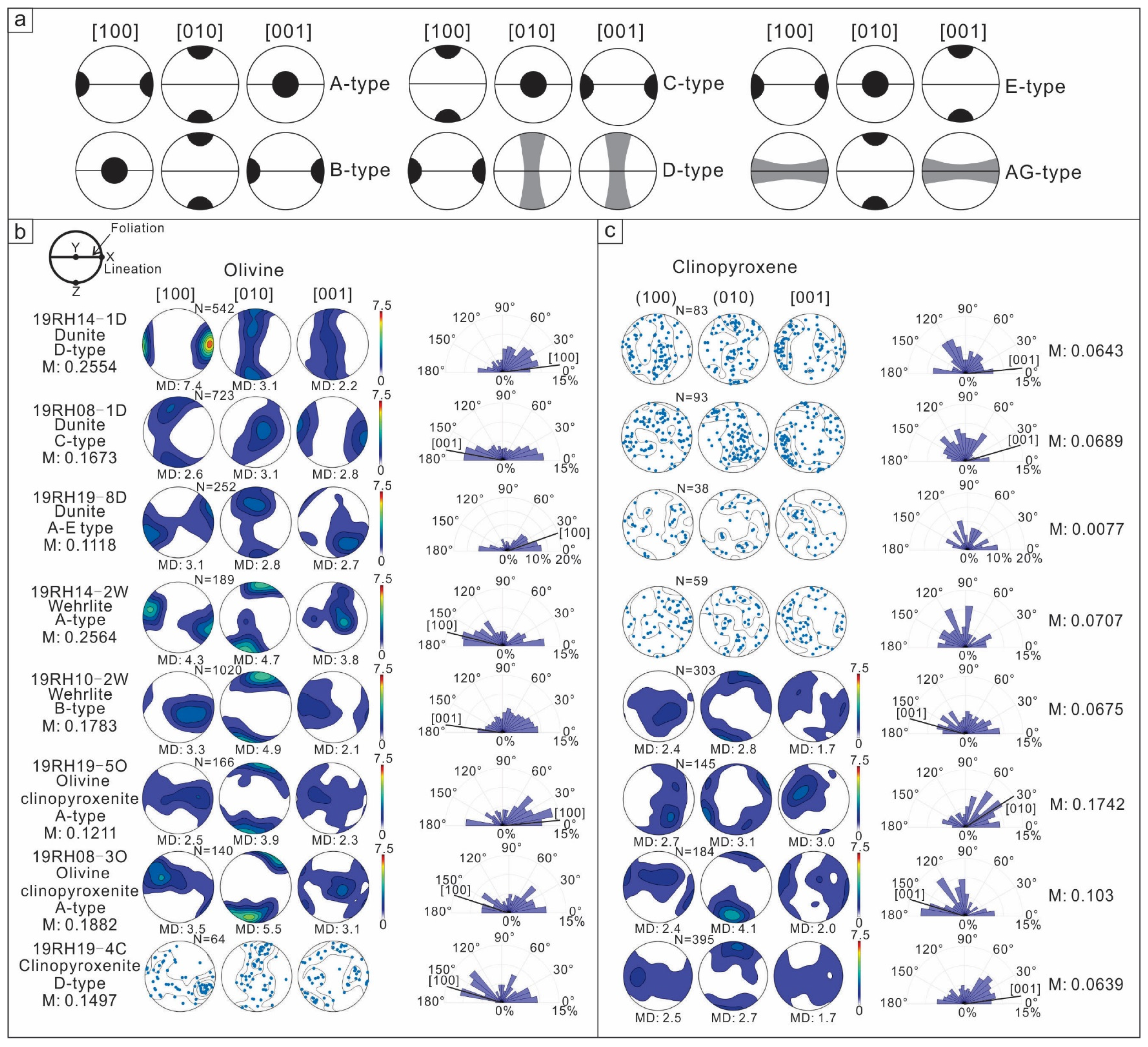

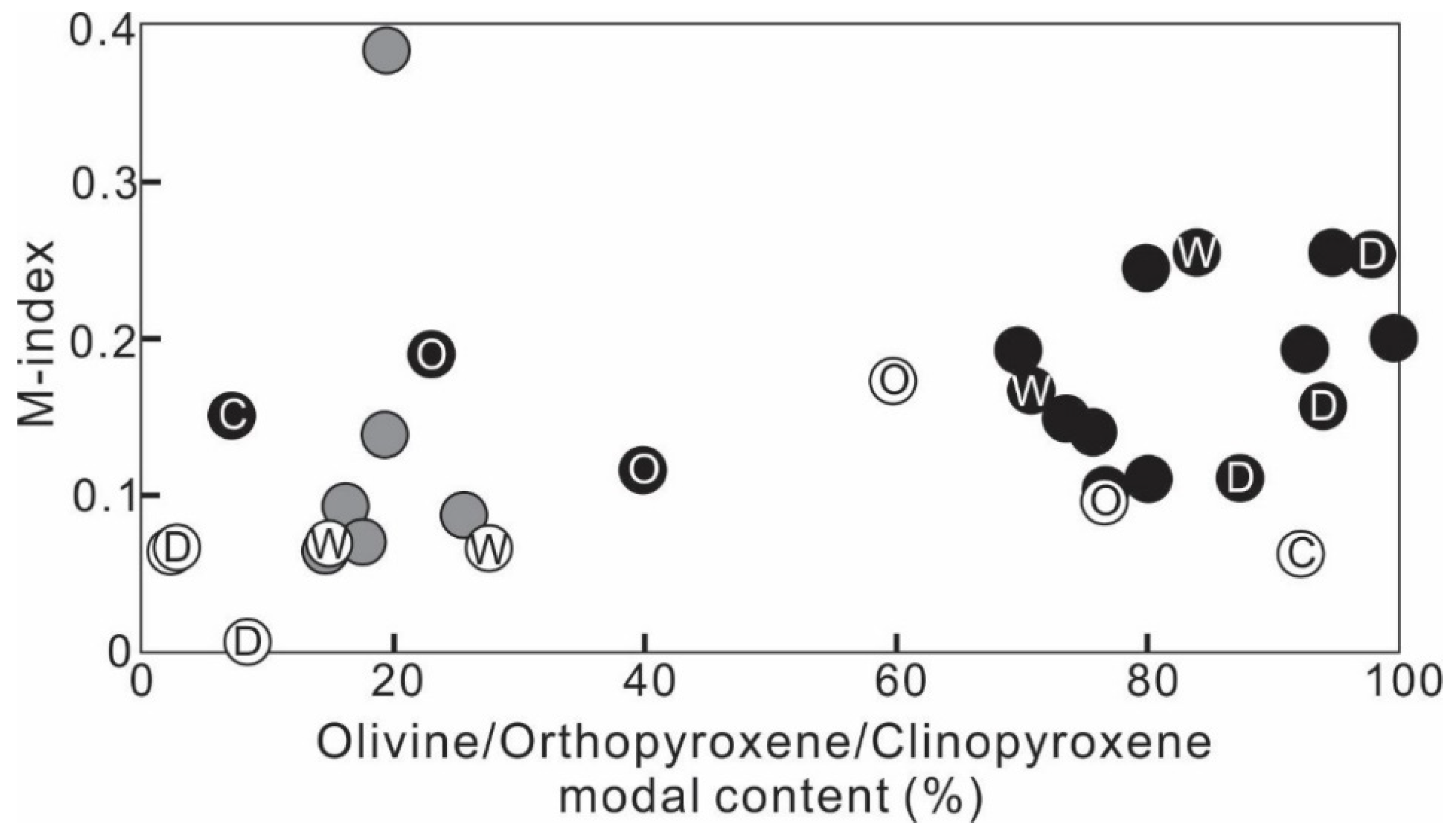
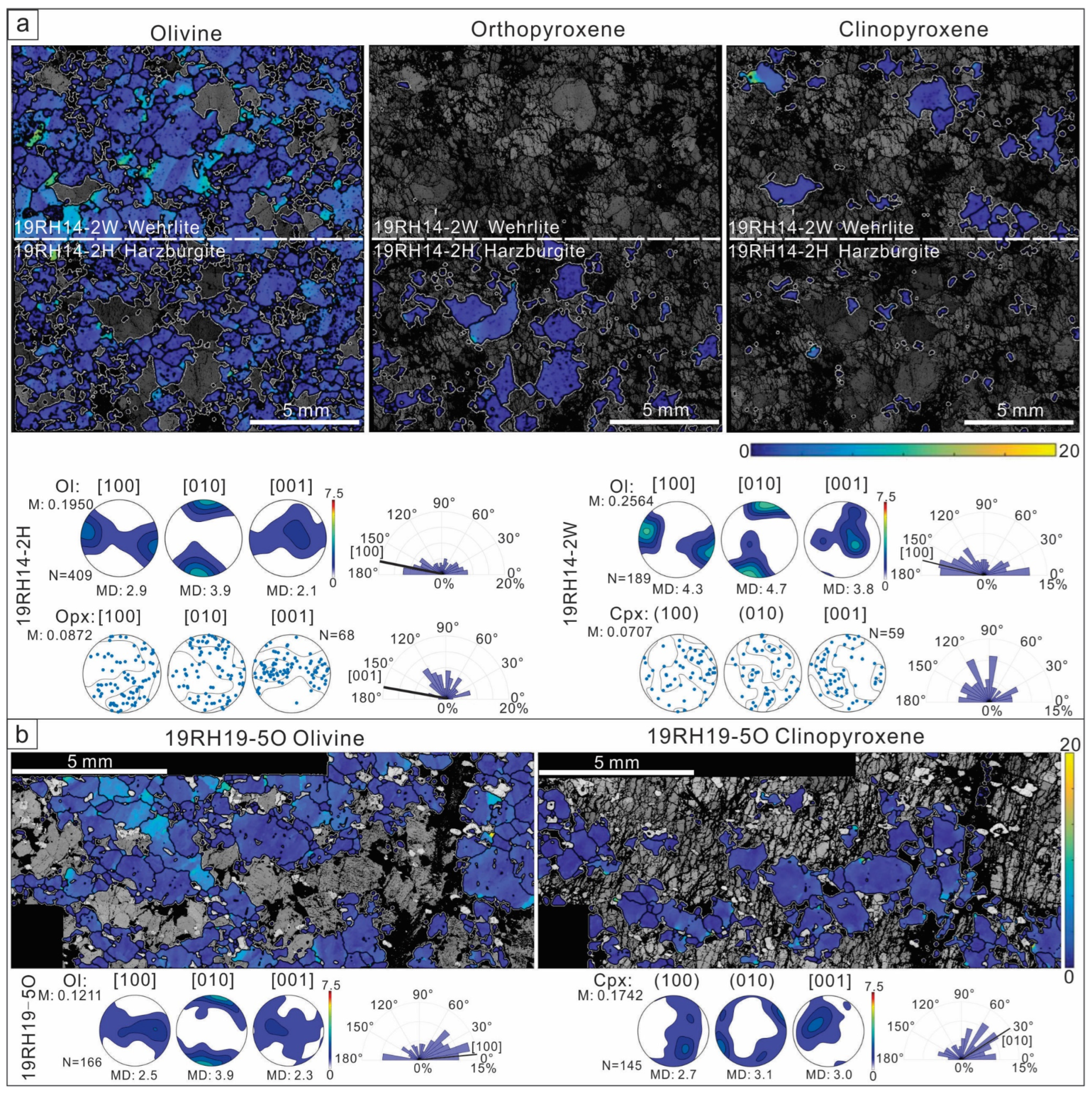

| Sample No. | Lithology | Ol (%) | Opx (%) | Cpx (%) | Sp (%) | Ol CPO Type | Ol Grain Size (μm) | Ol Grain Median (μm) | Ol M Index | BA Index | Cpx CPO | Cpx CPO Type | Cpx Grain Size (μm) | Cpx Grain Median (μm) | Cpx M Index | LS Index | Ol and Cpx Coherence a |
|---|---|---|---|---|---|---|---|---|---|---|---|---|---|---|---|---|---|
| 19RH14-1D | Dunite | 97 (97.6) | 0.0 | 2.3 (2.4) | 0.7 | D-type | 676 ± 589 | 619 | 0.2554 | 0.8276 | [001] | SL | 309 ± 138 | 304 | 0.0643 | 0.6113 | Y |
| 19RH08-1D | Dunite | 94.2 (96.9) | 0.2 | 3.0 (3.1) | 2.6 | C-type | 747 ± 486 | 582 | 0.1673 | 0.4937 | [001] | SL | 371 ± 148 | 327 | 0.0689 | 0.4185 | N |
| 19RH19-8D | Dunite | 87.6 (91.3) | 1.7 | 8.3 (8.7) | 2.4 | A–E type | 776 ± 678 | 525 | 0.1118 | 0.4426 | N/A | SL | 408 ± 179 | 360 | 0.0077 | 0.574 | N |
| 19RH14-2W | Wehrlite | 83.2 (84.6) | 1.4 | 15.1 (15.4) | 0.3 | A-type | 645 ± 485 | 494 | 0.2564 | 0.5766 | N/A | S | 502 ± 338 | 358 | 0.0707 | 0.2236 | N |
| 19RH10-2W | Wehrlite | 71.7 (72.2) | 0.3 | 27.6 (27.8) | 0.4 | B-type | 571 ± 412 | 432 | 0.1783 | 0.5404 | (010) [001] | SL | 639 ± 497 | 438 | 0.0675 | 0.5365 | Y (S) |
| 19RH19-5O | Olivine clinopyroxenite | 39.8 (40.0) | 0.1 | 59.8 (60.0) | 0.3 | A-type | 460 ± 255 | 373 | 0.1211 | 0.4151 | (100) [010] | SL | 565 ± 458 | 405 | 0.1742 | 0.6145 | N |
| 19RH08-3O | Olivine clinopyroxenite | 22.7 (22.7) | 0.2 | 77.1 (77.3) | 0.0 | A-type | 457 ± 287 | 349 | 0.1882 | 0.3205 | (010) [001]/[100] | SL | 792 ± 536 | 678 | 0.103 | 0.3529 | Y (S) |
| 19RH19-4C | Clinopyroxenite | 7.3 (7.3) | 0.4 | 92.3 (92.7) | 0.0 | D-type | 390 ± 394 | 279 | 0.1497 | 0.7023 | (010) [001]/[100] | S | 694 ± 493 | 528 | 0.0639 | 0.1912 | N |
| Sample No. | Modal Content (%) | Opx Grain Size (μm) | Opx Grain Size Median (μm) | Opx M Index |
|---|---|---|---|---|
| 19RH14-1H | 16.1 | 471 ± 275 | 399 | 0.0928 |
| 19RH14-2H | 25.5 | 507 ± 365 | 351 | 0.0872 |
| 19RH19-8H | 17.5 | 422 ± 281 | 443 | 0.0713 |
| 19RH19-9H | 14.8 | 454 ± 301 | 468 | 0.0696 |
| 19RH03-2H | 19.4 | 474 ± 258 | 463 | 0.3838 |
| 19RH08-1H | 19.2 | 504 ± 313 | 390 | 0.1396 |
Disclaimer/Publisher’s Note: The statements, opinions and data contained in all publications are solely those of the individual author(s) and contributor(s) and not of MDPI and/or the editor(s). MDPI and/or the editor(s) disclaim responsibility for any injury to people or property resulting from any ideas, methods, instructions or products referred to in the content. |
© 2023 by the authors. Licensee MDPI, Basel, Switzerland. This article is an open access article distributed under the terms and conditions of the Creative Commons Attribution (CC BY) license (https://creativecommons.org/licenses/by/4.0/).
Share and Cite
Shao, Y.; Negrini, M.; Liu, C.; Gao, R. Microstructural Relationship between Olivine and Clinopyroxene in Ultramafic Rocks from the Red Hills Massif, Dun Mountain Ophiolite. Minerals 2023, 13, 1415. https://doi.org/10.3390/min13111415
Shao Y, Negrini M, Liu C, Gao R. Microstructural Relationship between Olivine and Clinopyroxene in Ultramafic Rocks from the Red Hills Massif, Dun Mountain Ophiolite. Minerals. 2023; 13(11):1415. https://doi.org/10.3390/min13111415
Chicago/Turabian StyleShao, Yilun, Marianne Negrini, Cai Liu, and Rui Gao. 2023. "Microstructural Relationship between Olivine and Clinopyroxene in Ultramafic Rocks from the Red Hills Massif, Dun Mountain Ophiolite" Minerals 13, no. 11: 1415. https://doi.org/10.3390/min13111415
APA StyleShao, Y., Negrini, M., Liu, C., & Gao, R. (2023). Microstructural Relationship between Olivine and Clinopyroxene in Ultramafic Rocks from the Red Hills Massif, Dun Mountain Ophiolite. Minerals, 13(11), 1415. https://doi.org/10.3390/min13111415





